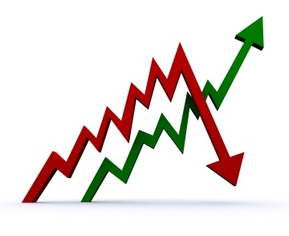Great analysis of how Skynet will take over the world and nuke mankind back to the stone age. In all seriousness, a great read if you believe robotics will have a significant impact on our economy and our labor force over the next few decades. While I believe the author comes to a “pie in the sky” conclusion, the reality is brutal.
Today’s robots can already replace some of the blue color/white color workers at the cost of $3.40/hour. With technology improvements the cost of robotics is expected to plummet over the next decade. Will anyone be able to compete against $1.10/hour robots who don’t whine, form unions or take pissing breaks? Let me think about that for a second.

—————————————————————————————————————————————
The Bear’s Lair: What happens when the robots take over?
February 3, 2014 posted by Martin Hutchinson
The economic disruption will be considerable, but robots will likely be a boon to the economy by pushing technological frontiers and facilitating entrepreneurship.
MIT professors Erik Brynjolfsson and Andrew McAfee in their new book, “The Second Machine Age” (Norton, 2014), look at recent advances in machine capability and suggest that we are going through a second Industrial Revolution, with robots soon capable of taking over massive new areas of human activity. Their picture of a world with ubiquitous robots is interesting but lacks definition; there is rather too much popular, but fallacious, economics and not enough futuristic robot wisdom. I thought therefore that I would fill the gap, using their admirable analysis of what robots might be able to do and consider, using better economics albeit infinitely less understanding of robots, what kind of a world this would produce.
The move to a world of robots has been slower than the 1950s expected. On the one hand, Moore’s Law, formulated by Intel founder Gordon Moore in 1965 and which says that the capacity and speed of computers doubles every two years, has been fully in operation since that time. On the other hand, many quite simple operations are in fact very difficult indeed for robots to carry out. For example, according to “The Second Machine Age,” it currently takes a robot fully 24 minutes to fold a towel.
This makes robots a lot less useful than they might be. The Jetsons world of a universal robot housemaid is still decades away. If it takes a robot 24 minutes to fold a towel, it presumably takes it several hours to make a bed properly and days-upon-days to clear up the living room after the kids have been through. We therefore are reduced for the foreseeable future to the simple iRobot Roomba, an admirable machine that is nevertheless modestly capable only of vacuuming the apartments of compulsive neat-freaks who don’t scatter junk about.
The most exciting part of the book is its description of the ways in which the power of computers is beginning to make things possible that were previously regarded as beyond the machines’ capability. While the doubling period has slowed somewhat, from little over a year to about two years, sophisticated advances in design have enabled engineers to overcome physical barriers that had been thought impenetrable.
That means that problems that appear impossible may be relatively straightforward only a decade later when computers are some 32 times more powerful and faster. In 2004, a DARPA race for self-driving cars was a fiasco; ten years later Google self-driving cars are buzzing all around the streets of Mountain View (although there still may be difficulties in extreme driving situations). Beating Grandmasters at chess was the great achievement of IBM’s Watson in the late 1990s; 15 years later Watson can even match wits with the far greater intellects of “Jeopardy” champions (though switch to “Wheel of Fortune” without reprogramming and Watson is toast).
There is thus good news for harried homeowners: the move to a “Jetsons” robot housemaid is only a matter of time. For example the robot which takes 24 minutes to fold a towel simply needs a few more iterations of Moore’s Law. After 10 more iterations, in 2034, the robot will be able to fold a towel in 1/1,024 of its present time, or 1.4 seconds. Problem solved: the towel closet will no longer be a baffling intellectual Matterhorn for the robotic household help.
Before rejoicing at the future capabilities available to us, we should however remember the Great Moore’s Law Compensator, propounded by Niklaus Wirth in 1995, which says that software is growing more sluggish and complex faster than computer power is increasing. For example, according to a 2008 InfoWorld article, the 2007 version of Microsoft Office performed approximately half as fast on a 2007 computer as the 2000 version did on a 2000 computer.
The entry into robot bliss is thus not guaranteed. What’s more, the authors lose considerable credibility when they take a mechanistic approach to technological change, asserting that very little changed in the millennium before 1750 and that “human population growth and social development were very nearly flat until the steam engine came along.”
While I defer to nobody in my admiration for Song Dynasty China, the fact remains that from about 1500 technological change was rapid in the West. In Britain, at least, this was accompanied by considerable economic growth. Anyone who has read N.A. M. Rodger’s excellent history of the British Navy, for example, will know that Nelson’s flagship “Victory,” built in 1759, could have blown the entire 1588 Spanish Armada out of the water single-handedly because of its guns’ greater range, higher muzzle velocity and much faster reload time.
Even today, productivity has advanced less than you think. The great Earl of Clarendon, exiled in 1667, compiled his magnificent “History of the Great Rebellion” of about 1.2 million words, a three-volume autobiography, an excellent refutation of Hobbes’ “Leviathan” and several other books—a total of about 2 million carefully researched words—almost entirely in the seven years before he died. And he was working with a quill pen, in candlelight and moving from one temporary exile abode to another, haunted by the illnesses of old age and seventeenth-century medicine. Given the amount of learning involved and the quality of the prose, there is no modern writer who could do as well, with all his modern equipment.
While a computer could certainly compose 2 million words in half an hour or so, they would be rubbish, little better than the output of a million monkeys on typewriters. Even at the level of investment recommendations, one can easily spot the automated ones, and however many further iterations of Moore’s Law we get, they are not going to enable a computer to write like Clarendon. Typesetting and proofreading Clarendon’s “History” took the Oxford University Press several years in 1699-1703; that would certainly be quicker today, but the actual writing wouldn’t.
One area where future robots may provide major productivity lifts, however, is medicine. IBM is already attempting to turn Watson into “Dr. Watson,” capable of undertaking medical diagnosis. The theoretical knowledge is of course no problem here; the difficulty is applying that knowledge to individual cases. Once diagnosis is possible, one can imagine robots undertaking surgery—presumably only after they have got towel-folding down cold. There are a number of mechanical operations in surgery that one would not wish carried out at one hundredth the normal speed.
This offers the possibility of a really major advance. Medicine is, after all, only maintenance of the human body; it is thus ridiculous that it should cost 17% of GDP. It’s as if a $30,000 automobile required $5,000 of garage work every year in order to keep it on the road. That may have been the case with the unreliable beasts of 1910, but today the maintenance proportion is far below that. Similarly, we can envisage medical costs being reduced by robotics to the 5% of GDP or so that they historically averaged in 1960. That would leave 12% of GDP available for other things and relieve a huge burden from government budgets.
The authors’ economic prescriptions for dealing with a robotized world are disappointing – standard Whig rubbish including higher taxes on the rich, handouts to the unemployable impoverished and, incredibly, more immigration in spite of their assumption of massive low-skill unemployment. Their one really helpful insight is that in many areas a combination of machine and human can produce results superior either to unaided humans or unaided machines (apparently a man-machine combination can still ace “Jeopardy” against IBM’s Watson.) Presumably a man/machine combination might prove especially capable in the medical area, at least for highly specialized processes.
At first sight, that sounds like a solution to the unemployment problem the authors so eloquently point out. As robots take over household and low-wage tasks, such as janitorial services, landscaping, food service and low-end retail, people can be attached to the robots in areas where a robot-human combination is optimal. However, there are almost certainly far too many humans for this to work, because as in a modern factory one human will be able to supply the “human factor” for a dozen robots or more, leaving a huge surplus of unemployed labor. Once again, as in so many other areas of human activity, when one looks forward one is forced to the conclusion that the system will only work properly with a population perhaps one tenth of that today – in other words about the 1 billion humans of 1800 about which the authors are so scathing. Maybe the population increase that accompanied industrialization isn’t permanently sustainable after all, but merely a giant blip.
Contrary to the authors’ estimate, I do not see further inequality or mass unemployment from the robot revolution. By all means, there will be actresses and athletes paid excessive sums, as the entertainment complex has always valued the tiny extra stratum of excellence. For the rest of us, however, apart from those who design robots or interact with them in some way, there will be the universe of “long-tail” products and services appealing to a small minority audience.
Authors, artists and musicians have always made a living appealing to a relatively small group of connoisseurs. While J.K. Rowling is a billionaire, that kind of wealth from the arts is a modern phenomenon. Dr. Johnson, the most successful writer of his age, was only able to live comfortably because of a royal pension of £300 per annum granted by George III. In a world of robots and 3D printing, the opportunities for specialized, quirky, non-machine-made output in the arts and crafts (or, by all means, “twerking” pop music) will be much greater than today, and hundreds of millions may find satisfaction and a modest living thereby.
I can almost get enthusiastic about the advent of genuinely functional robots. I was brought up in the 1950s and 1960s expecting that everything would be robotized by now, so it’s good that it’s actually happening. The economic disruption will be considerable, but I refuse to believe we will enter a world where 80% of the population lives on welfare while the other 20% pay 90% income taxes to support them. Instead, I think arts and crafts will support far more of us than they do today, while others will work with the robots and a small group will push forward the technological frontiers or engage in entrepreneurship. It will be a more prosperous world if we have fewer people. But that also is a problem we can solve if we have to, possibly through interstellar travel—that other fantasy of the 1950s that has been unaccountably delayed. Above all, it will still be free, and we will be richer, not poorer.














